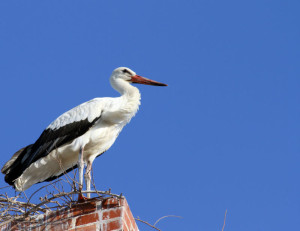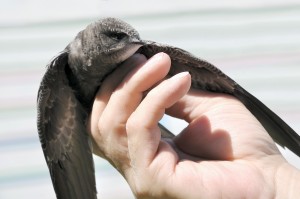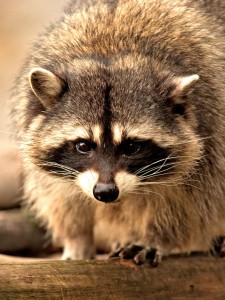Spring and summer are the nesting season for many animals. While you may enjoy seeing birds nests in your trees or a rabbit den in the backyard, there is one place you do not want animals to nest – in your chimney.
Many birds and small mammals view a chimney as the perfect place to nest and protect their young. While the chimney is a cool, dark, protected, and enclosed space, it can be dangerous and difficult to navigate for many animals. Likewise, animal entry can cause significant damage to your chimney system. Because of this, it is important to have animals removed as soon as possible.
How Animals Get In
The most common ways for animals to enter a chimney is through a damaged chimney cap. Birds and small mammals can fit through holes and gaps just a few inches wide; raccoons have been known to use their claws and teeth to tear at the chimney cap in order to create a large enough hole for them to fit through.
The Dangers Of Animals In The Chimney
The presence of animals in the chimney can cause damage to your fireplace system and affect future burning performance. One of the primary ways animals cause damage is to the chimney liner. In addition to scratching it with their claws, teeth, and beaks, nesting materials can also have a corrosive and weakening effect on the liner.
Nesting materials, discarded food, and animal droppings can also create chimney blockages. When dry, these materials can be extremely flammable, increasing the risk of chimney fire if they ignite. The presence of animals can also cause strong odors as well as expose your family to bugs, parasites, or bacteria.
Getting Animals Out
If you have animals in your chimney, it is important have them professionally removed as soon as possible. Working with a chimney company to have the animals removed ensures that not only will the animals and their nesting materials be safely removed, but that minimal additional damage will be done to your chimney.
Not all animals can be immediately removed; chimney swifts and other species of migratory birds are protected by federal law. Removing protected migratory bird nests can come with a hefty fine. Luckily, the nesting cycle for chimney swifts is relatively short; most hatchlings have left the nest in around 6 weeks, allowing homeowners to remove the nests and repair their point of entry after.
Preventing Animal Entry
Once the animals have been removed, it is important to take the steps to keep them from re-entering your chimney. One of the best ways to do this is by finding and securing their point of entry. Installing a new chimney cap, a stainless steel screen, or a rain cover can all help protect against animal reentry.
While it may be fun to spot baby animals out and about in nature, the last place we want to see them is in our chimneys. To protect your chimney against animal entry – or to have animals safely removed – contact Jack Pixley Sweeps today!
During the spring and summer, nesting birds can be found in tree tops, under the eaves of roof, and more. As much as you may enjoy listening to bird songs and chirps or watching baby birds grow from eggs and leave the nest, there is one place you do not want birds to take up residence – in your chimney.
While birds in your chimney may seem like just a nuisance, they can cause a surprising amount of damage. Because of this, it is recommended to have birds and bird nests safely and humanely removed as soon as possible. Unfortunately, there are several species of migratory birds, including chimney swifts, that are protected by federal law and cannot be removed.
Recognizing chimney swifts
Chimney swifts are small, grey and brown migratory birds that can be found nesting throughout the Midwest during the spring and summer. While these birds once preferred hollow trees to nest in, urbanization caused them to adapt and begin nesting in chimneys. Swifts are easily recognizable with small, cigar shaped bodies, a distinctive call, and unique, jerky flight patterns.
How swifts get into your chimney
Chimney swifts are easily access the flue through damaged chimney caps. Because they are so small, they can squeeze through holes or gaps as small as just a few inches. Once inside the chimney, swifts built their nests vertically against the walls of the flue. In addition to damaging the flue and the chimney liner, nesting materials can create blockages that prevent proper drafting and droppings can cause damage throughout the chimney system.
Give chimney swifts a proper home!
Whether you have had swifts in your chimney in the past or simply want to help provide safe nesting grounds for these migratory birds, it is easy to create a proper home for chimney swifts!
Because they prefer tall, narrow, enclosed spaces for nesting, building a nesting space for chimney swifts is as easy as building a box. Using rough plywood, construct a narrow box approximately 12 feet high, with a 1 square foot opening near the top. This gives chimney swifts an alternative nesting site, keeping them safe – and hopefully out of your chimney.
I think I have chimney swifts – now what?
If you have swifts in your chimney, there is little that can be done; because they are federally protected by the Migratory Bird Treaty Act, they cannot be removed until the nesting cycle is complete. Luckily, this is relatively short and hatchlings should leave the nest within 6 weeks.
Once the hatchlings have left the nest, repairs can be made to the chimney. A certified chimney sweep can help remove the nest and other debris from the chimney; they can also identify how the swifts got in and repair the point of entry to prevent them from coming back in the future.
Chimney swifts may wreak havoc on our chimney systems, but it is still important to care for these migratory birds. Building an alternate home for chimney swifts to nest in can allow you to enjoy these unique birds – but not at the expense of your chimney. For more information on preventing chimney swift entry in your home, contact Jack Pixley Sweeps today!
Scratching and clawing are sounds no homeowner wants to hear coming from their chimney. If you do, you may have an animal trapped inside.
The presence of an animal in the chimney is more than just a nuisance; animals often endanger themselves by getting stuck, can cause serious damage to your chimney components, and can expose your family to disease. Because of this, it is important to call a chimney professional at the first sign of animal entry.
How animals get in
Birds, raccoons, squirrels, and a number of other animals are known for trying to find their way into chimneys. Commonly, animals are able to get into the flues of uncapped chimneys or homes where the chimney cap has been damaged. Chimney caps that are ill-fitting, have shifted, or have damaged side screens can all leave gaps big enough for animals to get into. Raccoons have also been known to claw and scratch chimney caps until they break to gain entry.
Keeping animals out
The best way to keep out of your chimney is through regular chimney maintenance. An annual chimney inspection can help spot damage to the chimney cap and other chimney components. If repairs are needed, they can be quickly and easily completed – before animals get in.
I think I have an animal in my chimney – now what?
If you hear clawing, scratching, crying, or other animal noises coming from your chimney it is important to call a chimney professional as soon as possible. While animals may be able to find their way in, most are not able to get out on their own; when trapped and disoriented in the dark, enclosed space, wildlife rescue may be needed.
It is never recommended for homeowners to attempt to “smoke out” animals. First, opening the damper to start a fire can let whatever animal is in your chimney into your home; it is much easier to get a bird out of a chimney than it is a living room! Likewise, starting a fire with an animal in the chimney can be harmful to the animal as well as your home. The smoke, heat, and gasses from the fire often kill the animals long before they are able to escape up the chimney. If there are nesting materials in the chimney, sparks and embers from the fire can cause them to ignite and lead to chimney fires.
At Jack Pixley Sweeps, we provide professional animal removal services. We identify the area the animal is trapped in and remove four bricks; this creates an area large enough for the animal to escape on its own or be removed without causing significant damage to the chimney. By having a chimney company remove the animal, we are able to not only get the animals out, but repair the damage they have caused and keep them from coming back.
The presence of an animal in your chimney endangers the animals, causes chimney damage, and can expose your family to a variety of bacteria or diseases. At Jack Pixley Sweeps, we are experts at removing animals from your chimney – and keeping them from coming back. Contact us today for more information on wild animal removal.
During the spring and fall, birds around the country begin their annual migrations for nesting season. One such bird is the chimney swift, which is known for spending its winters in South America before returning north to the United States and Canada for nesting season each summer. While swifts are beautiful to observe, they can cause serious problems for your chimney system.

How to recognize chimney swifts
If you have birds in your chimney, one of the hardest things to do is determining what they are. Luckily, there are several distinguishing characteristics that set chimney swifts apart from other birds.
- Size: Chimney swifts are extremely small birds known for their “cigar shaped” bodies. Swifts also have long, thin, pointed wings.
- Color: Swifts can be a dull gray or brown color. When seen in flight backlit against the sky they may appear black.
- Movement: Chimney swifts are almost always in flight and are rarely seen sitting unless in their nests. They can be identified by their sharp twists and movements in flight.
- Sound: Unlike songbirds, swifts have a distinctive high pitched chirp or call when flying.
I have swifts in my chimney. Now what?
If you wake up to the sounds of birds in your chimney, the first instinct is often to get them out. Unfortunately, chimney swifts cannot be so easily removed. Chimney swifts are one of many bird species protected by the Federal Migratory Birth Treaty Act. This act makes it illegal to remove or destroy chimney swift nests when eggs or hatchlings are present. Because of this, if a family of swifts finds their way into your chimney, there is nothing to do but wait for the young to leave the nest in approximately six weeks.
Why it’s important to keep chimney swifts out
Some homeowners, especially wildlife lovers or those who infrequently use their fireplaces, may not have a problem with chimney swifts nesting in their chimney. While its admirable to allow chimney swifts to nest in your chimney, it is not recommended and should be avoided if possible.
The first reason why you want to keep swifts out of your chimney is because they can cover disease. Migratory birds, including chimney swifts, can spread disease because “their ability to travel over long distances and through a variety of habitats exposes them to a wide range of microorganisms.” Likewise, the presence of nesting materials in the chimney structure often attracts a variety of bugs and insects which can also increase your risk of exposure to disease.
In addition to potentially bringing disease, chimney swifts can be a long-term problem. Like most migratory birds, chimney swifts prefer to return to the same nesting ground every year. This means that if your chimney is left uncapped or open to them they will continue to return and nest in your chimney each season. A new chimney cap or top mounted damper can keep swifts from returning even if they’ve nested in your chimney before.
While chimney swifts are a nuisance, they cannot be removed as easily as other animals. Because of this, it’s important to keep them from getting in to begin with. If you have had swifts in your chimney in the past or think you might currently have a swift nest, contact Jack Pixley Sweeps today!
Whether it’s flapping, scratching, climbing, or babies calling for their mother, hearing the sounds of animals inside your chimney can be an unsettling experience. Because they are safely protected from the elements, chimneys present an ideal hiding place or nesting ground for many birds and small mammals, especially in the spring time.

Unfortunately, the presence of animals in your chimney is dangerous for the animals and harmful to your family’s health and safety. Because of this, we recommend calling a chimney sweep or animal removal company as soon as you hear a noise in your chimney.
How do animals get into my chimney?
Animals, especially those seeking shelter from rain, cold temperatures, or predators, are extremely adept at finding their way into chimney structures. The primary way most animals get into your chimney structure is through a damaged or missing chimney cap. Some animals, like raccoons, will even claw or bite damaged portions of the chimney cap until they create a large enough hole for their entry.
A chimney cap protects the top of your chimney from not only animal entry, but also from moisture or other debris from getting into the flue. A top sealing damper works in the same way as a chimney cap as long as it is closed whenever the chimney is not in use.
What are the dangers of animals in my chimney?
If the top of the flue is unprotected, animals can easily enter the chimney structure to nest or seek shelter. Unfortunately, many animals cannot get out once they get in. Being in the dark of the narrow flue can be extremely disorienting, causing them to scratch – and therefore damage – the flue liner. In addition, nesting materials or animal droppings can create both strong odors and fire hazards. This debris may partially block the flue, prevent smoke and gas from properly exiting the chimney, or ignite when dried from stray sparks or embers.
Why should I have animals professionally removed?
Some intrepid homeowners may attempt to remove animals from their chimneys themselves. Unfortunately, this can be dangerous for you, your home, and the animals. First, homeowners should never attempt to “smoke out” animals in their chimneys, as the heat and gas from the fire will kill animals before they are able to exit the chimney. In addition, opening the damper to force animals into the firebox only serves as a way to expose you and your family to diseases carried by wild animals – or get a bird, raccoon, or squirrel trapped in your home.
When animals are alive and trapped in the chimney, removing a small portion of the masonry may be necessary to get them out. In order to prevent serious structural damage to the chimney structure, this should only be done by a professional. At Jack Pixley Sweeps, we have perfected a method of animal removal that only requires the removal of four bricks; once the animals are gone, we can easily repair the chimney damage and find ways to prevent the animals from coming back.
Contact Jack Pixley Sweeps at the first signs of animal entry to minimize damage to your chimney system!




